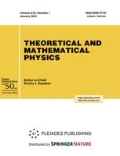Abstract
We discuss the stationary potential equations as illustrative examples to explain how to construct integrable symplectic maps via Bäcklund transformations. We first give a terse survey of Bäcklund transformations of the potential KdV equation and the potential fifth-order KdV equation. Then, using Jacobi–Ostrogradsky coordinates, we obtain canonical Hamiltonian forms of the stationary potential equations. Finally, we construct symplectic maps from the reduction of a Bäcklund transformation and verify that they are integrable.
Similar content being viewed by others
References
J. Hietarinta, N. Joshi, and F. W. Nijhoff, Discrete Systems and Integrability (Cambridge Texts in Applied Mathematics, Vol. 54), Cambridge Univ. Press, Cambridge (2016).
V. E. Adler, A. I. Bobenko, and Yu. B. Suris, “Classification of integrable equations on quad-graphs. The consistency approach,” Commun. Math. Phys., 233, 513–543 (2003).
M. Adler and P. van Moerbeke, “Toda–Darboux maps and vertex operators,” Internat. Math. Res. Notices, 489–511 (1998).
L. D. Faddeev and A. Y. Volkov, “Hirota equation as an example of integrable symplectic map,” Lett. Math. Phys., 32, 125–135 (1994).
B. Grammaticos, T. Tamizhmani, and Y. Kosmann-Schwarzbach (eds.), Discrete Integrable Systems (Lecture Notes in Physics, Vol. 644), Springer, Berlin–Heidelberg (2004).
J. Moser and A. P. Veselov, “Discrete versions of some classical integrable systems and factorization of matrix polynomials,” Commun. Math. Phys., 139, 217–243 (1991).
M. Bruschi, O. Ragnisco, P. M. Santini, and G. Z. Tu, “Integrable symplectic maps,” Phys. D, 49, 273–294 (1991).
Yu. B. Suris, The Problem of Integrable Discretization: Hamiltonian Approach (Progress in Mathematics, Vol. 219), Birkhäuser, Basel (2003).
A. P. Veselov, “Integrable maps,” Russian Math. Surveys, 46, 1–51 (1991).
D. Du, “Complex form, reduction and Lie–Poisson structure for the nonlinearized spectral problem of the Heisenberg hierarchy,” Phys. A, 303, 439–456 (2002).
D. Du and C. Cao, “The Lie–Poisson representation of the nonlinearized eigenvalue problem of the Kac–van Moerbeke hierarchy,” Phys. Lett. A, 278, 209–224 (2001).
Y. Wu and D. Du, “On the Lie–Poisson structure of the nonlinearized discrete eigenvalue problem,” J. Math. Phys., 41, 5832–5848 (2000).
C. Cao and X. Xu, “A finite genus solution of the H1 model,” J. Phys. A: Math. Theor., 45, 055213, 13 pp. (2012).
C. Cao and G. Zhang, “A finite genus solution of the Hirota equation via integrable symplectic maps,” J. Phys. A: Math. Theor., 45, 095203, 25 pp. (2012).
C. Cao, Y. Wu, and X. Geng, “Relation between the Kadomtsev–Petviashvili equation and the confocal involutive system,” J. Math. Phys., 40, 3948–3970 (1999).
C. Cao, “Nonlinearization of the Lax system for AKNS hierarchy,” Sci. China Ser. A, 33, 528–536 (1990).
C. Cao and X. Geng, “C Neumann and Bargmann systems associated with the coupled KdV soliton hierarchy,” J. Phys. A: Math. Gen., 23, 4117–4125 (1990).
Y. Wu and X. Geng, “A new integrable symplectic map of Neumann type,” J. Phys. Soc. Japan, 68, 784–790 (1999).
A. P. Fordy, “Integrable symplectic maps,” in: Symmetries and Integrability of Difference Equations (London Mathematical Society Lecture Note Series, Vol. 225, P. A. Clarkson, F. W. Nijhoff, eds.), Cambridge Univ. Press, Cambridge (1999), pp. 43–55.
A. P. Fordy, A. B. Shabat, and A. P. Veselov, “Factorization and Poisson correspondences,” Theoret. and Math. Phys., 105, 1369–1386 (1995).
G. L. Lamb, Jr., Elements of Soliton Theory, Wiley, New York (1980).
Funding
This work was supported by National Natural Science Foundation of China (Project No. 11271337).
Author information
Authors and Affiliations
Corresponding author
Ethics declarations
The authors declare no conflicts of interest.
Additional information
Translated from Teoreticheskaya i Matematicheskaya Fizika, 2021, Vol. 208, pp. 39-50 https://doi.org/10.4213/tmf10023.
Rights and permissions
About this article
Cite this article
Du, D., Liu, Y. & Wang, X. Integrable symplectic maps via reduction of Bäcklund transformation. Theor Math Phys 208, 886–895 (2021). https://doi.org/10.1134/S0040577921070035
Received:
Revised:
Accepted:
Published:
Issue Date:
DOI: https://doi.org/10.1134/S0040577921070035




